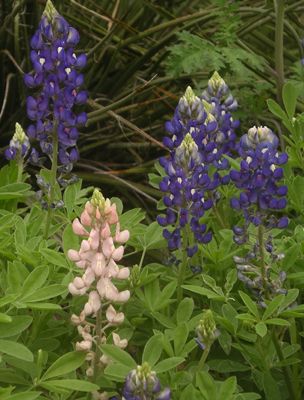
pink appearing out of the blue
 pink appearing out of the blue |
Just a slight mistake at the genetic level, and a flower can end up different than the norm. Of course, this sort of thing is much sought after in the commercial plant industry, since the human species delights in variety, and the appearance of a new color or shape can be downright exciting. Look at what happened in the Dutch tulip mania of 1636-37. Mutations, and their careful development and cultivation, account for the wide choice of plants we enjoy putting in our gardens. People spend a lot of time coaxing an unusual form or hue of a traditional plant into a commercially viable cultivar in order to patent and then sell it to a public constantly seeking the exotic or novel.
But those same "mistakes" that eventually become popular new garden plants also occur regularly in the wild. If nobody sees them, they just wilt and fade away into obscurity, like many millions of their kind. The careful observer, though, can enjoy the thrill of finding a weird flower every now and then.
One feature that is very easy to notice is color. A really stunning example occurs with bluebonnets. These blue lupines are one of the few flowers that almost all Texans can recognize, and every spring they carpet large areas of rocky land in the Hill Country. Whereas many kinds of flowers need soil, bluebonnets do best in gravel, not minding that the overlying earth has long since washed away. They grow for only a short period of mild temperatures, dying off as spring rapidly warms to summer. Their tough seeds, though, can wait patiently until the next time optimum growing conditions exist. Everyone knows that bluebonnet blossoms are, well, blue. But that is not always the case. Occasionally a plant will produce pink, white, or red flowers. It is a mutation, and it must somehow be a bit detrimental to the plants. Otherwise, over the years there would be a variety of colors, much like lupines in the mountains of Colorado. But here in Texas, blue prevails to the extent that an individual plant with flowers of any other color looks as out of place as a single Picasso in a Monet exhibit.
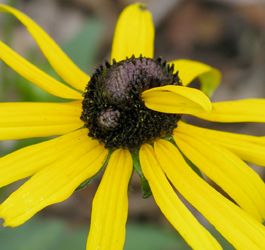 a petal in the wrong place! | 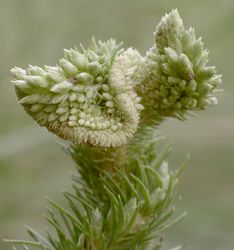 crested liatris inflorescence | 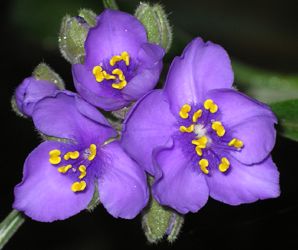 spiderwort with five petals |
A relatively simple way that flowers can vary from the norm is in the number of petals. Just like four-leaf clovers, blooms that usually have three petals sometimes have one or two more.
 a sunflower with no brown center |
Some of the best candidates for mutant flowers are the composites. This family of plants, as the name suggests, have flowers consisting of a group of relatively small blossoms that grow together to form a larger bloom. Sunflowers, daisies, fleabanes, and dandelions are all examples. The typical blossom consists of disk flowers, which are in the middle, and ray flowers, which surround the disk. While the disk flowers do not have any part that is long and particularly colorful, the ray flowers each have a bit that sticks out, forming what we recognize as a petal. There is a center of growth, around which all the individual flowers radiate, and each little bloom will produce a seed once it is pollinated. When so many individuals are involved, the likelihood of error increases accordingly. What if a disk flower happens to produce a petal? Or what if all the ray flowers never do? The wild sunflower shown here grew with no brown center, only a big cluster of yellow petals looking like a cultivated chrysanthemum. The same plant also produced normal blossoms as well as some that had more ray flowers than usual with correspondingly reduced disks.
Not all composites have differentiated ray and disk flowers. Thistles do not look like daisies, and that is because all their purple flowers have the same structure, creating the puff-like effect we expect on that plant. But even species like liatris can mutate. The stem of the flower stalk, or inflorescence, might lose its center of focus and then form a tangled crest of buds that folds around in serpentine fashion instead of growing up straight and tall. When the buds open, the whole grouping will look much more clustered, barely resembling the usual spike of evenly spaced blossoms.
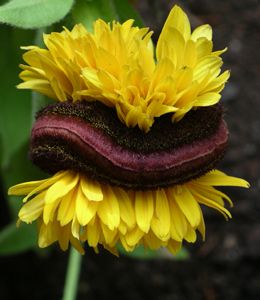 imaginative brown-eyed Susan | 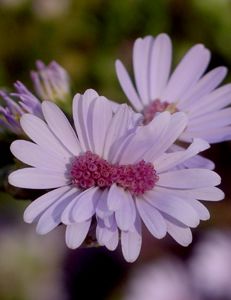 like a dividing paramecium |  gaillardia with a difference |
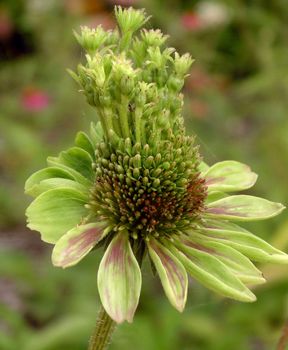 crazy coneflower |
Spending a lot of time outdoors taking photos, I never pass up a chance to snap pictures of any unusual plant I find. The purple coneflower illustrated here is perhaps the most ornately strange inflorescence I've seen. Not only are the ray flowers green instead of purple, but the disk flowers went wild. While it's weird enough that petals might be produced, a good portion of these blossoms became new miniature buds! Magritte or Dali would be impressed.
From the simple stimulus to produce a structure that would attract animal pollinators, the flowers of plants are now so numerous that we cannot imagine our world without them. Their diversity is a constant source of inspiration and delight. It's pleasant enough to appreciate a large field of gaillardia or sunflowers, but the added surprise of finding a mutant bloom among them is better than icing on the cake. It is also less fattening.